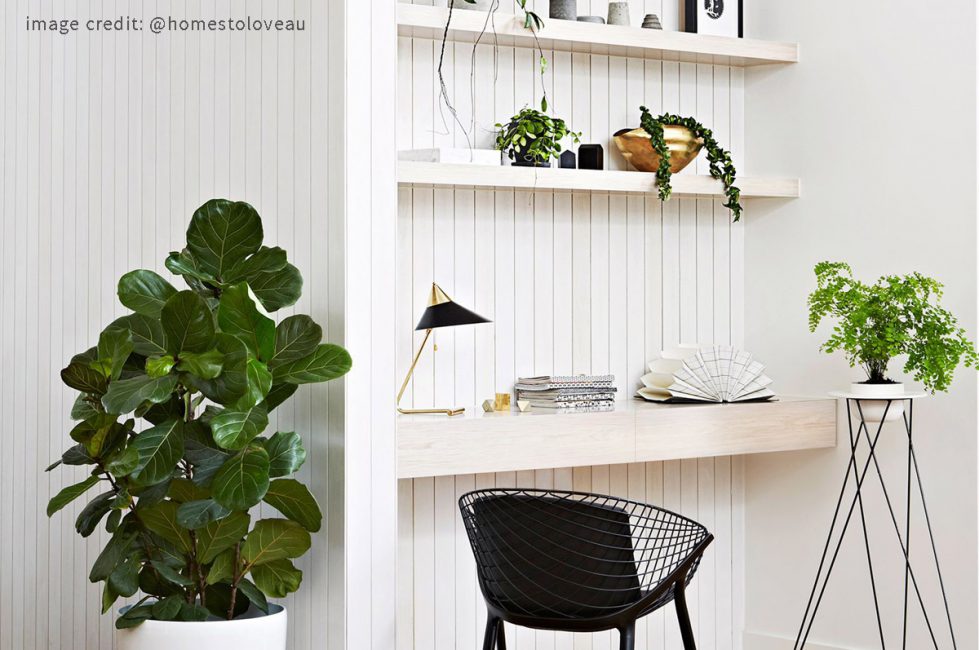At MUSE we feel a room is never complete without at least one plant in it. The reason being is simple, plants add life and vitality to a room. They help purify the air and add a sense of calmness and serenity to a space.
Our top 10 tips to green up your home.
- Scale – know how large a plant will grow and plant in appropriate pot with drainage. Learn a little about what your chosen plant likes, and follow instructions. If it’s a slow growing plant you may scale your planters as your plant grown so whilst small it doesn’t look lost in a large pot.
- Light – know your varieties. Generally waxy dark foliage plants need less light. Succulents need much more. Before choosing your plant, research the preferred light conditions your plant will grow under. If you don’t get it exactly right your plant will let you know. Look for obvious signs like yellowing leaves, wilting, and less obvious ones like in the case of succulents, leggy stems. If you are unsure Facebook has hundreds of plant groups around the world where one can join and ask questions, where a large and knowledgeable gardening community is always at hand ready to help.
- Soil – Choose the right potting mix or make your own. In this area it is true that you get what you pay for, and although it may cost a little more upfront, your plants will reward you. Potting mixes which adhere to Australian standards will have the five tick logo. These potting mixes will have better consistency, aeration, ph level and will hold water better than cheaper mixes which tend to by hydrophobic. Also ensure you select the right mix for your plant, for example a succulent will do better in a cacti and succulent mix than an orchid would. Choose the mix formulated for your plant.
- Watering – Ah that old chestnut.. if you are uncertain how often to water check the label or Google to see if your plant needs to be watered often or infrequently. For a few dollars a moisture gauge can be a great investment. These are inexpensive and available from Bunnings. Some plants really suffer if their roots sit in too much moisture so ensure your pots have drainage.
- Feeding – Like us, plants need food. It’s a good idea to keep the information labels stored in one place so you can refer to them when you need to. There are many fertilizer options available, liquid, granules, tablets and sticks you place in the soil. We prefer slow release fertilizers as the application is not as regular and they distribute the nutrients evenly. Osmocote, Thrive and Baileys are reputable brands you can start with confidence. Keep in mind that for plants that are watered often the nutrients are leached out of the soil faster, so be sure to top up your fertilizer from time to time.
- Drainage – Always provide adequate drainage. If you have bought a planter without a drainage outlet, put one in before planting. If you are handy, invest in a diamond tip drill and go to work. To protect your drill bit ensure it doesn’t get hot by adding a little water to where you are going to drill. Go slow and add water as you go. With this method you will be able to drill through most materials including glass, ceramic and porcelain. If you are feeling uncertain, try a practice run on an old mason jar or something similar. To protect your furniture and floor coverings, it is prudent to invest in good trays. If you purchase terracotta trays double check that water doesn’t slowly permeate onto the surface below as in some instances the moisture can become trapped underneath resulting in unsightly marks.
- Soaking – It’s always good practice to collect your plants all up and sit them in a sink full of water for a while. The water travels up the pot and gives the plant a really good drink. Do this infrequently and your plants will love you for it. This method of watering is particularly effective for succulents which only need to be watered when the soil is completely dried out.
- Circulation – Another great tip is to take your plants outside for some morning sun from time to time. This is particularly beneficial in spring after the plants have been inside over winter. Please note, plants may experience stress if you put them in too an extreme condition. Do this slowly and cautiously. Do not put plants in direct sunlight straight away, let them acclimatize in dappled light. The goal is to let them take in the fresh air and breeze. Over a period of a week or so let them take in some morning light before taking them back indoors.
- Location – Although adequate light an important factor in selecting the perfect plant for the perfect spot, it is not the only one, so is humidity and temperature. Plants such as ferns thrive in bathrooms as they love the daily misting. Cacti and succulents prefer a drier air and warmer temperature. Select your location wisely, however if a plant is not doing well, don’t be afraid to experiment, but be mindful to give your plant adequate time to adapt to its new position. If you see the leaves turning to the light source it’s a sign that light levels may be too low.
- Mobility – For large and heavy plants consider putting the pot on wheels. This will help you to take it outside for annual re potting as well as other maintenance tasks.
Happy Indoor Gardening!

